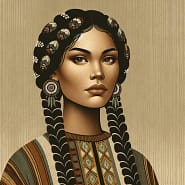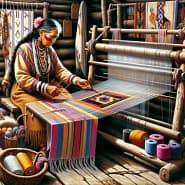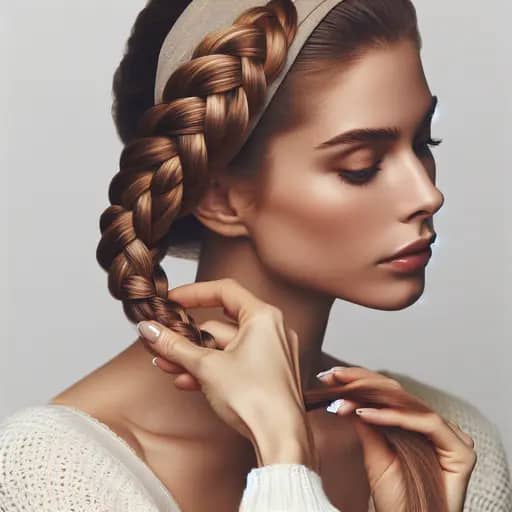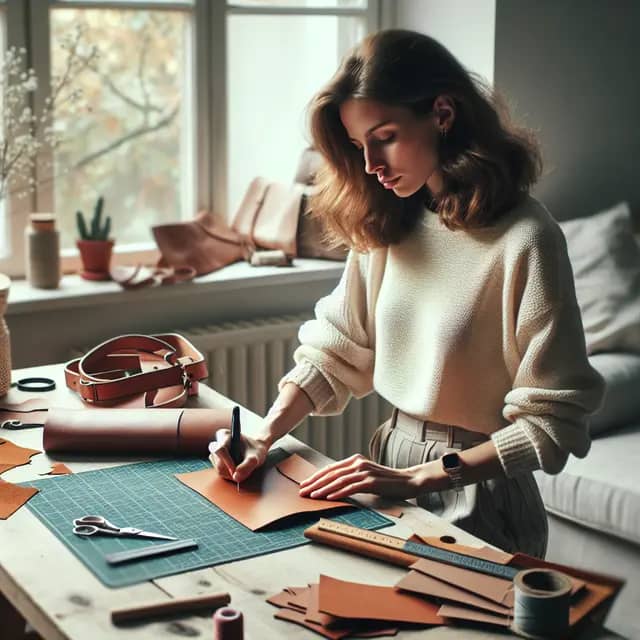Introduction: The Beauty of French Braids
Few hairstyles are as timeless and elegant as the French braid. Whether you’re preparing for a day at the office or dressing up for a lavish night out, French braids can enhance your overall look with a touch of sophistication and chic style. But, what really makes French braids so special? Let’s delve into the compelling world of this versatile hairstyle.
- Aesthetic appeal: The intricate interweaving of hair strands makes French braids an eye-catching accessory. It is perfect for showcasing individual style and adds an extra dose of beauty to any look.
- Versatility: From formal occasions to casual outings, French braids suit a variety of events. They can also be adapted to various hair types and lengths – proving their dynamic nature.
- Convenience: French braids are not only stylish but also practical. They help to keep hair away from the face, making them ideal for activities where loose hair could be a nuisance.
- Blend of tradition and novelty: While the French braid’s history is enriched with cultural significance (which we’ll cover later on), contemporary twists and modern adaptations keep it at the forefront of hairstyling trends.
Admittedly, the art of French braiding may seem daunting to many. However, with the right guidance, patience, and practice, it’s a technique that can be mastered by anyone. This article aims to be your comprehensive guide in this adventure, exploring the elegance of French braids and providing you with all the insights you need to start creating your own beautiful braids.
From understanding the history and cultural significance of French braids, to learning about its various forms and the tools required, we’ll cover it all. We’ll also share expert tips for perfecting the French braiding technique and discuss how to take care of your braided hair.
Ready to begin your French braiding journey? Let’s dive in!
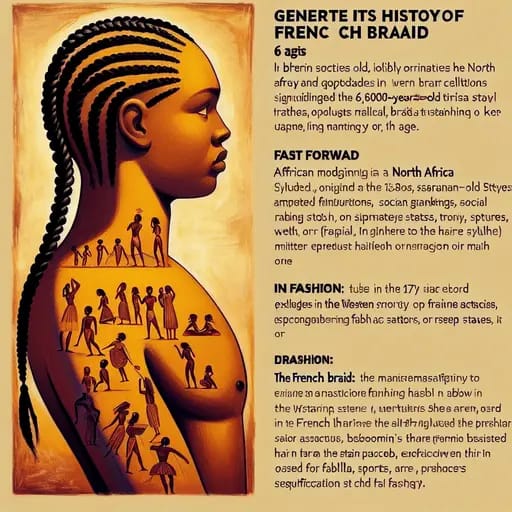
History of French braiding and cultural significance
Unraveling the threads of the past, the history of French braiding takes us back hundreds of years. Despite its name, French braiding didn’t originate in France. Let’s step back in time and explore how French braiding has evolved over the centuries, and its cultural importance.
- Ancient Origins: Historians speculate that the intricate hairstyle originated in North Africa, with some debate pointing towards Algeria. Its earliest record is found in a rock painting in the Saharan desert dated 6,000 years ago, demonstrating a man with a styled, neatly-woven French braid. HistoricMysteries offers more insights on this topic.
- Fashion Waves in the 18th Century: The hairstyle caught the western world’s attention in the 18th century when it became identified as “French” braid. The trend was captured in a short story published in an 1871 American magazine, marking its first literary mention.
- Modern Revival: French braiding re-emerged in mainstream fashion during the late 20th century, evolving into a variety of styles and forms that we see often today.
While the French braid is deeply rooted in culture and identity, it’s also a symbol of intricate beauty and timeless elegance. Its versatility and functionality make it appropriate for a myriad of events, from red carpet galas to gym workouts.
- African Heritage: In many African cultures, the braid styles varied by tribe, signifying an individual’s tribe, marital status, age, wealth, or social ranking. Braiding was a societal bonding activity among women and girls, who would spend time creating each other’s hairdos.
- Practical Functionality: For fields such as ballet, sports, and military, French braids offered a practical solution to keep hair closely secured and prevent it from obstructing the face.
- Aesthetic Appeal: In the fashion world, the French braid is esteemed for its complex appearance that adds sophistication to any outfit or event.
In conclusion, the French braid is not just a hairstyle; it’s a testament to human creativity and the personification of an individual’s culture and identity. No doubt, mastering the art of French braiding gives one a taste of history and beauty, intertwined in each strand of hair.
Now that we know about the tapestry of history that French Braiding carries with it, let’s dive into the variances of this hairstyle in the contemporary world in our next section: “Different types of French braids and how to achieve them”.
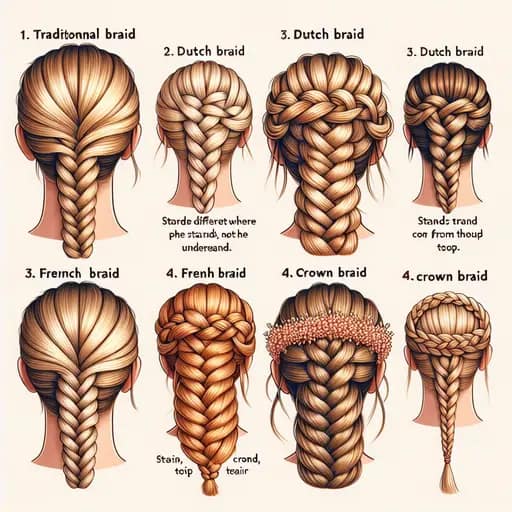
Different types of French Braids and How to Achieve Them
French braids are timeless and versatile, offering a range of styles for all hair types and lengths. From the elegant single French braid to the intricate fishtail braid, there’s a style to suit any occasion. This section will cover the different types of French braids and guide you through the process of mastering each style.
1. Traditional French Braid
The traditional French braid is a classic staple. This style starts with three strands at the crown of the head, gradually incorporating more hair into the braid as you move down. Check out this step-by-step guide on how to create a traditional French Braid.
2. Dutch Braid
A Dutch braid, sometimes referred to as an “inverse French braid”, creates a 3D effect as the braid sits on top of the hair rather than woven into it. By simply reversing the technique of a traditional French braid, you can achieve this unique style. Follow this Dutch braid tutorial for a detailed guide.
- Key differences: While a French braid includes hair strands coming from underneath, in Dutch braids, they come from the top.
3. Fishtail French Braid
A Fishtail French braid is given its name because of its intricate resemblance to a fish’s tail. Although this style might appear daunting due to its detailed appearance, it’s relatively simple when you get the hang of it. Here’s a tutorial to help you master the fishtail French braid.
4. Crown French Braid
For a romantic and fairy-tale like hairstyle, the crown French braid is your go-to. This braid wraps around your head like a headband, creating an enchanting look. Here’s an easy guide to achieving this look.
By adding these versatile and timeless styles to your hairstyling repertoire, you’ll be able to transform your hair for any occasion. Whether you’re mastering the art of the traditional French braid, or shaking things up with a Dutch or Fishtail style, there’s a French braid to suit your personal taste and style.
Up next, we’ll delve deeper into the tools and products needed for French braiding. Stay tuned!

Tools and Products Needed for French Braiding
Conquering the art of French braiding isn’t just about mastering the technique, but also about gathering the right tools and products. From the brush you use to detangle your hair to the hair ties that secure your creation, these seemingly trivial items can make the difference between ordinary braids and breathtaking French braids.
A Comprehensive List of Essential Tools and Products:
- Hairbrush: A good hairbrush is the beginning of any hair styling routine. A paddle brush is ideal for detangling and smoothing hair before a French braid.
- Sectioning Clips: Sectioning clips come in handy when you are creating multiple braids or if you have particularly thick hair.
- Hair Elastics: Thin hair elastic bands are the most important tool to secure the braids. They should be strong, stretchy, and resilient.
- Bobby Pins: Hidden beneath your braid, bobby pins can provide extra support and shape to your French braid.
- Mirror: Especially if you’re a beginner, a good-sized mirror is a must-have for monitoring your braiding progress and ensuring a clean, even look.
Elevate Your French Braid with These Products:
- Texturizing Spray: Adding some texturizing spray or sea salt spray to your hair prior to braiding can create a firmer grip and hold, making the styling process easier.
- Smoothing Serum: A small drop of this product can tame flyaways, prevent frizz, and add shine, enhancing the elegance of your French braid.
- Hairspray: A light mist of hairspray can secure your style in place and add a final touch of shine.
Crafting the perfect French braid requires technique and practice, but remember – the right tools and products are also in your hands. Embrace the journey and shine with your stunning braid!
*Please note that everyone’s hair is unique. What works best for one person may not work as well for another. Experiment with different tools and products to see what works best for your hair type and texture*.
Now that you know about the useful tools and products, let’s dive into tips for mastering the technique of French braiding in the next section.
Tips for Mastering the Technique of French Braiding
Mastering any new skill can be a challenge, and French braiding is no exception. However, with a clear understanding of the process and some careful practice, it’s possible to become a pro in a relatively short amount of time. Here are some key strategies to help you on your journey to mastering the art of French braiding:
1. Practice with Wet Hair
When you’re starting out, practice on wet hair. Wet hair is generally more manageable and less prone to flyaways. It makes the learning process a little less stressful and a lot more enjoyable.
2. Split Hair Evenly
When beginning your braid, divide hair into three equal sections. This ensures that the braid will be even and balanced, which is the essence of a classy French braid.
3. Maintain Tension
Keep a firm grip on the hair as you’re braiding. Maintaining tension helps to create clean, tight braids. However, ensure not to pull too tightly as it could cause discomfort or damage to the hair and scalp.
4. Watch and Learn
Utilize online tutorials and visual guides. Simply reading about the technique isn’t always enough. Watching someone else do it, especially if they’re able to explain what they’re doing as they go, can be incredibly helpful.
5. Practice, Practice, Practice
Finally, the age-old adage applies: practice makes perfect. Don’t be discouraged if your first few attempts don’t go as planned. Keep going, and you’ll get the hang of it. Happy braiding!
In mastering the art of French braiding, these steps are proven strategies, yet finding the methods that work best for you could involve some trial-and-error. Be patient with yourself and remember that every expert was once a beginner too. Keep practicing and soon, you’ll be able to create stunning French braids with ease.
ctn-tg>Use these tips today and get one step closer to mastering the art of French braiding.

Frequently asked questions about French braiding
In the quest for mastering the art of French braiding, you may come across numerous questions about the process, styling, or hair care. Here, we aim to answer a few common questions to shed some light on the intricacies of the French braid:
1. Can I French Braid my own hair?
Absolutely, it is a skill that one can learn with practice. It might seem challenging at first, but with our expert guide on how to achieve different types of French braids, you can become proficient in no time!
2. What type of hair works best for French braiding?
French braids can work with almost all hair types – be it straight, curly, short or long. However, braiding can be easier when the hair is slightly damp or prepped with styling products we discuss in Tools and products needed for French braiding section.
3. Is French braiding damaging to hair?
When done properly, French braiding is one of the most protective hairstyles out there. Find our tips for maintenance in Maintenance and care for French braided hair.
4. How long will a French braid last?
A French braid can last from a few hours to even a few days, depending on your hair type, the method you used, and how well you have taken care of it. Check out our section on Tips for mastering the technique of French braiding, to make your braids last longer.
5. How do I sleep with French braids?
Wearing a silk scarf or sleeping on a silk pillowcase can prevent frizz and help your French braids stay intact all night long. Learn more tips in our following part: Maintenance and care for French braided hair.
6. Are there different types of French braids?
Yes, there are many different variations of French braids. We explore them in depth in our section: Different types of French braids and how to achieve them.
Just remember, like mastering any art, becoming proficent in French braiding will be a journey, so enjoy each step you take. Keep these questions and their answers in mind as you continue your voyage into the world of French braiding.
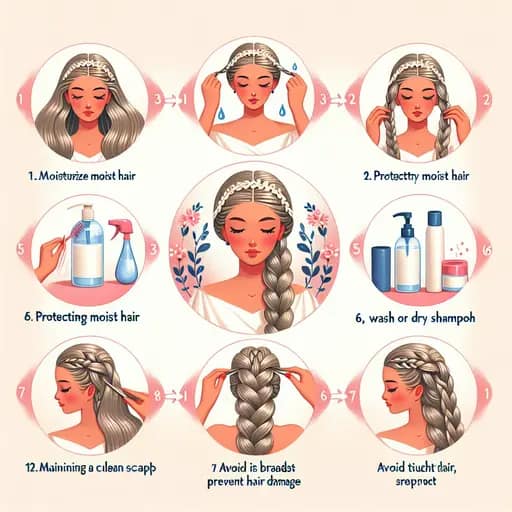
Maintenance and Care for French Braided Hair
Mastering the art of French braiding involves more than just knowing the technique. Proper maintenance and care for French braided hair are equally crucial to ensure that your braids remain neat, healthy, and stunning. Below are some practical care tips:
- Moisture is Essential: Keep your braids moisturized. This can be done easily by spritzing your hair lightly with water or using a quality hair moisturizer product.
- Use a Satin/Silk Scarf: Protect your braids at nighttime by wearing a satin or silk scarf or using a satin pillowcase. It helps to keep the braids intact and prevents frizz.
- Keep Your Scalp Clean: It’s important to maintain a clean scalp for healthy hair. Use a braid refresher spray or a dry shampoo to clean your scalp in between wash days.
- Avoid Tight Braids: Be sure not to braid your hair too tightly. Increased tension can cause breakage and lead to a condition known as traction alopecia.
- Regular Maintenance: Regularly taking down, washing, and re-braiding your hair can ensure optimal hair health and fresh looking braids.
Beyond these general care and maintenance tips, it’s important to remember that care routines can vary depending on one’s hair type and texture. As you proceed with mastering the art of French braiding, be sure to research and find what works best for your hair type. Remember, achieving beautiful and healthy French braids is a marathon, not a sprint. Patience and consistency with the care and maintenance routine will reap stunning results in the end. Happy braiding!
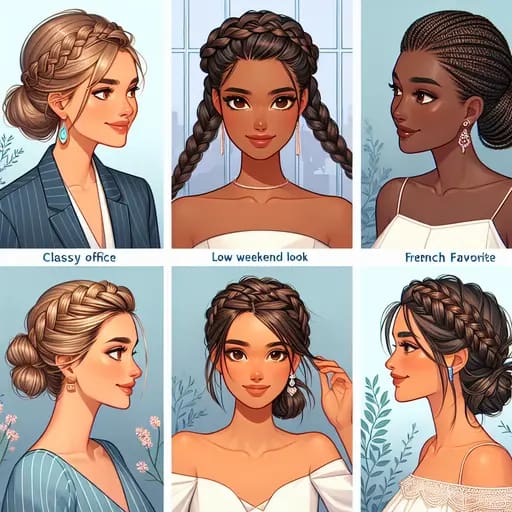
Inspirational French braid styles for different occasions
If you’ve been following along in this article, you’ll know that French braiding is not only a great way to keep hair out of your way, but also an art form with diverse variations. Depending on the occasion, French braids can exude class, charm, sophistication, and even boldness. Let’s look at some inspirational French braid styles suitable for various occasions.
- Classy Office Look: The Low French Braid Bun
Perfect for a professional setting, the low French braid bun gives a sophisticated look.
- Weekend Fun: French Braid Pigtails
This style is chic yet playful, perfect for a relaxed weekend outing. It’s also a favorite among athletes for being both fashionable and functional.
- Summer Favorite: The Messy Side French Braid
A messy side French braid is an ideal pick for a summer look – loose, carefree, and perfect for beach outings or garden parties.
- Elegant Event: French Braid Chignon
Pair your fancy dresses with a French braid chignon for an elegant evening. This hairstyle exudes elegance and keeps your hair comfortably in place.
A point to remember: no matter the occasion, a French braid can be tailored to meet the mood. The beauty of a French braid lies in its versatility and adaptability.
From the casual to the stylish, each of these looks takes the classic French braid and adds a unique twist to it. Which one is your favorite? Let us know in the comments!
Read on to uncover ways to maintain and care for your French-braided hair and keep it looking flawless.
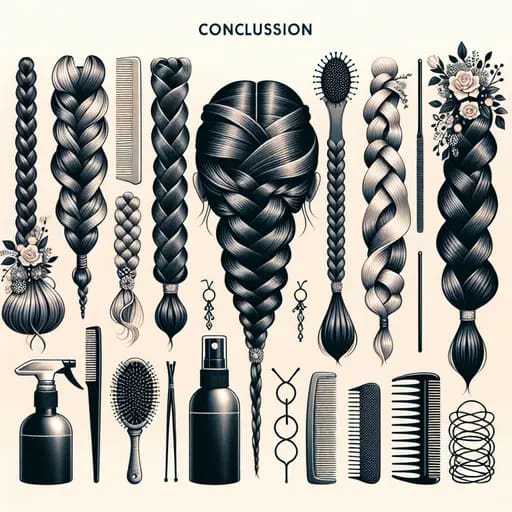
Conclusion: Embracing the Elegance of French Braids
The art of French braiding is not only about mastering a hairstyle, but about embracing a style that is both timeless and versatile, exuding grace and elegance. This article introduced the basic steps, different braiding styles, and essentials needed to achieve the perfect French braid. Whether you embark on this journey for style, convenience or cultural appreciation, it is essential to remember that practice and patience are your best allies.
Key takeaways from the article:
- French braids are ingrained in history and hold cultural significance.
- From classic to fishtail, there are diverse French braid styles to explore and master.
- Proper tools like combs, hair ties, and hair spray play an important role in creating flawless braids.
- Achieving a perfect French braid requires practice, neater parts, and smoother strands.
- Caring for your braid involves regular moisturizing and covering hair before sleeping to maintain the braid longer.
French braids are more than just a hairstyle; they are a symbol of grace, sophistication, and commitment to learning a skill. They are suitable for every occasion, lending charm to a casual day out or adding elegance to formal attire.
Moreover, French braids are an excellent protective style that aids in growth and reduces damage. Don’t let the intricacy of braiding deter you from learning this art. Embrace the elegance of French braids, and add a timeless piece to your hairstyle repertoire.
Ready to start your French braid journey? Bookmark this article, and let it guide you as you progress from a novice braider to a braiding master.


